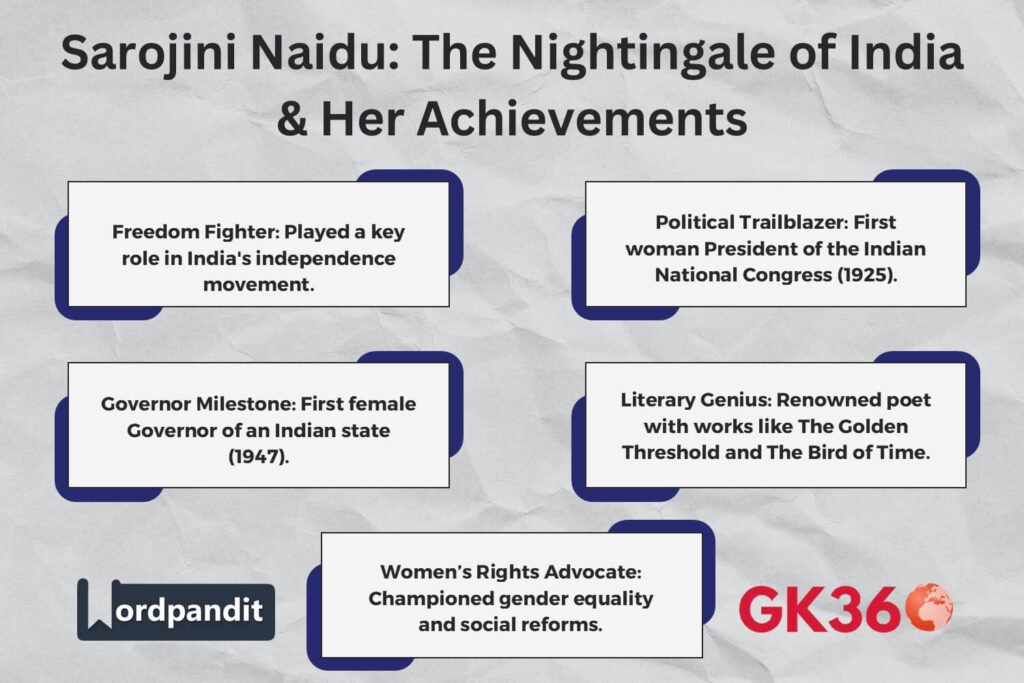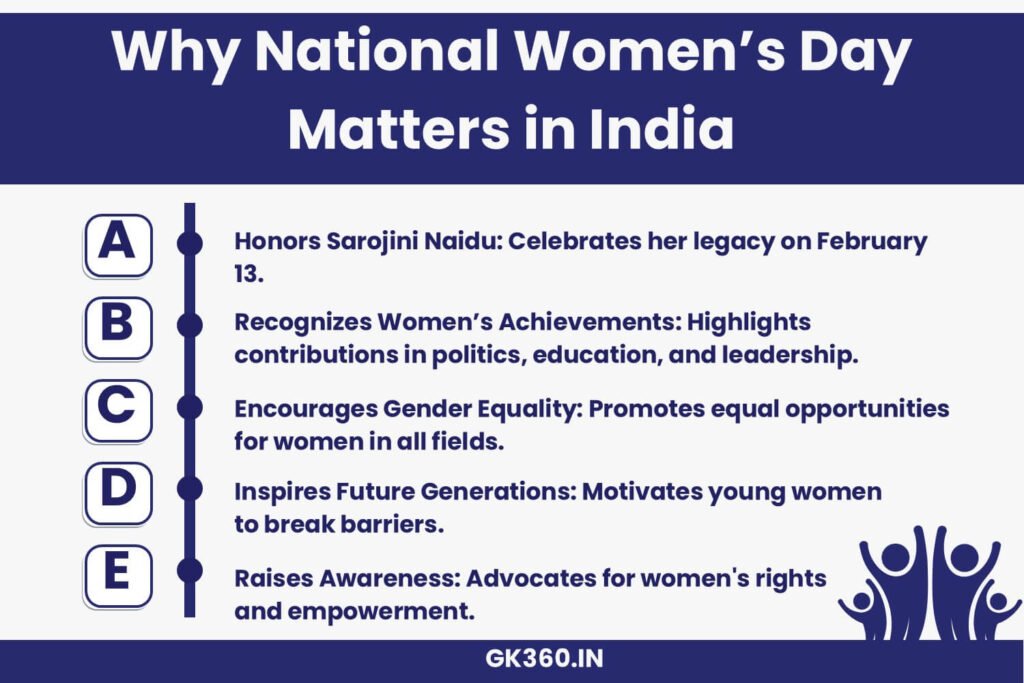National Women’s Day India 2025: Sarojini Naidu’s Legacy & Women’s Empowerment
Introduction
Every year, India celebrates National Women’s Day on February 13 to honor the birth anniversary of Sarojini Naidu, a trailblazing poet, freedom fighter, and women’s rights advocate. Known as the “Nightingale of India”, she played a pivotal role in India’s independence movement and championed gender equality.
This day serves as a reminder of women’s empowerment and the need for equal opportunities in politics, education, and leadership. Through her legacy, Sarojini Naidu continues to inspire generations of women to break barriers and shape the future.

Table of Contents
- What is National Women’s Day in India?
- History and Significance of National Women’s Day
- Sarojini Naidu’s Role in India’s Freedom Struggle
- Her Achievements and “Firsts”
- Literary Contributions of Sarojini Naidu
- Inspiring Facts About Sarojini Naidu
- How India Celebrates National Women’s Day
- FAQs
- Conclusion: Why Sarojini Naidu’s Legacy Matters Today
What is National Women’s Day in India?
National Women’s Day is an annual observance dedicated to celebrating women’s achievements, leadership, and contributions to Indian society. Unlike International Women’s Day (March 8), this national event focuses on honoring an iconic Indian woman leader—Sarojini Naidu, who fought for women’s empowerment and social justice.
History and Significance of National Women’s Day
The Government of India designated February 13 as National Women’s Day to commemorate Sarojini Naidu’s immense contributions to politics, literature, and social reform.
📌 Why Is National Women’s Day Important?
- Recognizes the achievements of Indian women in various fields.
- Encourages gender equality and women’s participation in leadership roles.
- Raises awareness about women’s rights and empowerment.
- Inspires young women to pursue their dreams, education, and careers.
Sarojini Naidu’s Role in India’s Freedom Struggle
Sarojini Naidu was a key figure in the Indian Nationalist Movement and worked closely with leaders like Mahatma Gandhi and Jawaharlal Nehru.
🏛 Her Major Contributions:
- First Woman President of the Indian National Congress (1925).
- Actively participated in the Civil Disobedience Movement and Quit India Movement (1942).
- Arrested multiple times for her anti-British resistance.
- First Female Governor of an Indian state (United Provinces, now Uttar Pradesh) post-independence (1947-1949).
Her unwavering determination paved the way for women’s leadership in Indian politics.
Her Achievements and “Firsts”
Sarojini Naidu achieved several milestones that inspired countless women in India and beyond.
🏅 Trailblazing Achievements:
- First Indian woman to become President of the Indian National Congress.
- First woman to be appointed as a Governor of an Indian state.
- First Indian woman to address the British Parliament, advocating for India’s independence.
- A pioneer in inter-caste marriage, defying rigid social norms.
- Led India’s first delegation to the South African Indian Congress (1929), fighting for the rights of Indians abroad.
Through her achievements, Sarojini Naidu redefined women’s roles in politics and society.
Literary Contributions of Sarojini Naidu
Apart from being a political leader, Sarojini Naidu was a celebrated poet whose works beautifully captured patriotism, nature, and Indian heritage. Her eloquent verses earned her the title “The Nightingale of India.”
📖 Famous Works by Sarojini Naidu:
- The Golden Threshold (1905) – Her debut poetry collection, praised for its vivid imagery and lyrical beauty.
- The Bird of Time (1912) – A compilation of poems expressing themes of freedom, struggle, and hope.
- The Broken Wing (1917) – Includes the iconic “The Gift of India”, a tribute to Indian soldiers in World War I.
- The Feather of the Dawn (1961, posthumously published) – A collection of her unpublished poems, edited by her daughter Padmaja Naidu.
Her profound poetry continues to inspire writers, activists, and artists worldwide.
Inspiring Facts About Sarojini Naidu
Here are 10 fascinating facts about Sarojini Naidu that highlight her extraordinary journey:
- Born into a scholarly family – Her father was a scientist, and her mother was a poet.
- A child prodigy – She topped the Matriculation Examination at Madras University at just 12 years old.
- Studied in England – Attended King’s College, London, and Girton College, Cambridge.
- Defied social norms – Married Dr. Govindarajulu Naidu in an inter-caste marriage at 19 years old.
- Awarded the Kaisar-i-Hind Medal for her humanitarian work during a plague epidemic (later returned in protest).
- Led women’s groups in the Salt Satyagraha (1930) against British taxation.
- Arrested multiple times for her role in the independence movement.
- Represented India internationally, advocating for Indians’ rights in South Africa.
- First Female Governor of India – Appointed in 1947.
- Died in office while serving as Governor of Uttar Pradesh (1949).
Her life story continues to be an inspiration for women’s empowerment worldwide.
How India Celebrates National Women’s Day
Every year, India celebrates National Women’s Day through various initiatives that promote women’s empowerment and gender equality.
🌟 Key Ways India Observes This Day:
- ✨ Educational Seminars & Talks: Discussions on women’s rights, leadership, and equality.
- ✨ Cultural Events & Competitions: Poetry recitals, debates, and exhibitions honoring Sarojini Naidu’s legacy.
- ✨ Government Initiatives: Launch of new women’s empowerment programs and policies.
- ✨ Social Media Campaigns: Nationwide efforts to spread awareness about gender equality.
- ✨ Award Ceremonies: Recognizing outstanding contributions by women in various fields.
This day serves as a reminder to continue striving for gender equality, women’s leadership, and social justice.
FAQs
1️⃣ Why is National Women’s Day celebrated on February 13?
It marks the birth anniversary of Sarojini Naidu, a pioneering leader who fought for women’s rights and India’s independence.
2️⃣ What are Sarojini Naidu’s major achievements?
She was India’s first woman Congress President, the first female Governor, and a key leader in the freedom movement.
3️⃣ How did Sarojini Naidu contribute to gender equality?
She advocated for women’s education, voting rights, and leadership roles in Indian politics.
4️⃣ What is Sarojini Naidu’s most famous poem?
“The Gift of India”, a tribute to Indian soldiers who fought in World War I.
5️⃣ How can we celebrate National Women’s Day?
By learning about women’s history, supporting gender equality initiatives, and empowering women in society.
Conclusion: Why Sarojini Naidu’s Legacy Matters Today
Sarojini Naidu was more than a poet—she was a visionary leader, freedom fighter, and advocate for women’s rights. Her relentless fight for India’s independence and gender equality paved the way for future generations of women leaders.
As we celebrate National Women’s Day 2025, let’s honor her legacy by empowering women, supporting equal rights, and fostering a society where every woman has the opportunity to thrive.
Key Takeaways
| Aspect | Details |
|---|---|
| Date of Celebration | February 13 (Birth anniversary of Sarojini Naidu). |
| Significance | Recognizes women’s achievements and promotes empowerment. |
| Sarojini Naidu’s Role | Freedom fighter, poet, and advocate for women’s rights. |
| Major Achievements | First female INC President, first female Governor of India. |
| Literary Contributions | The Golden Threshold, The Bird of Time, The Broken Wing. |
| Ways to Celebrate | Educational events, cultural programs, and awareness campaigns. |
| Impact on Society | Encourages gender equality and women’s leadership. |
Related Terms:
- National Women’s Day India 2025
- Sarojini Naidu Legacy
- Women’s Empowerment in India
- February 13 Women’s Day
- Role of Sarojini Naidu in Freedom Struggle
- Indian Women Leaders
- Sarojini Naidu Poetry
- First Female Governor of India
- Women’s Rights in India
- Gender Equality Awareness






